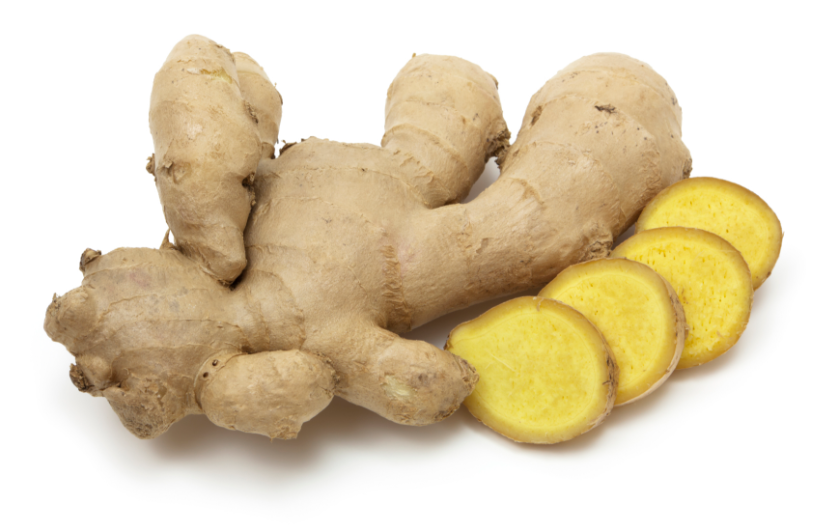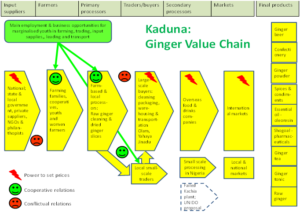
GINGER VALUE CHAIN
Our current focus in the food and agro sector has been on the harmonization of the efforts of ginger farmers in North Western Nigeria, where we represent a cluster of over 500 ginger farmers in Kafanchan, Kaduna state with a combined production capacity of over 3000 tonnes of ginger per annum.
Our partnership with other agro processing and regulatory organizations ensure compliance of these ginger products to quality standards to serve both local and international markets.
We are at present in talks with both local and international buyers seeking to secure purchase orders for both crude and processed ginger products.
You can always reach us via the contact page
Key thoughts on the ginger value chain.
The Ginger Value Chain
The main features of the ginger value chain are illustrated in this diagram below

Describing the Ginger Value Chain
Final products
Final products are shown in the column on the far right. These include raw ginger, ginger powder used as spice and for ginger drinks, confectionery and essential oils. The main final markets for these products are international, as shown in the central column to the left of final products. The local markets, illustrated at the bottom of the column, are much smaller, even though ginger is a household staple in the growing areas and is widely used in cooking by Nigerian households and restaurants.
Markets for ginger
Kaduna state holds close to 100% of the national market, and a significant share of international markets serving some major international markets such as Netherland, UK and Germany. This is because Kaduna state’s south-east LGAs, particularly Kachia, Kagarko and Jarba, but also to an extent, Jemm’a and Zango Kataf provide ideal growing conditions for the high quality, internationally sought-after taffin giwa and yatsum biris ginger varieties.
We are working with key public research partners to develop improved higher yielding variants of these varieties.
Secondary processing
The conversion of dried ginger and ginger essence into final products is done mainly outside Nigeria by companies located in the countries in which most of the final products are consumed. Though a number of small processing activities are conducted within Kaduna city, including production of ginger essence and the mixing of ginger with other spices to create spices for the Nigerian market, these secondary processors have not yet been able to break into international markets on a significant scale.
Primary processing
In contrast to secondary processing, which takes place mainly outside the country, virtually all the primary processing, namely the slicing and drying of ginger, is done within the country, mainly by farming families and small-scale local processors operating within the ginger growing areas of Kaduna state.
Current methods of primary processing are basic, with the roots being washed and sliced by hand. The sliced, raw ginger being laid out on rocks or on woven plastic carpets to dry.
Our intervention has therefore overseen an upgrade in these activities through our independent processing facility for mechanized cutting, sorting, cleaning and hygienic packaging to enhance the quality of the dried ginger at economic volumes and invariable increase the value-addition of this segment of the value chain.
Traders and transporters
There is a highly developed network of transporters and traders linking primary producers to large, expatriate buyers and to the smaller buyers who transport the products from the villages to local and national markets. This accounts for a significant percentage of the off-taker activity in the value chain.
The large traders, whose companies are foreign owned, and the local actors who operate individually in an intensively competitive environment are in intense price conflict because the price of dried, sliced ginger is set on international markets and the large buyers, who have access to international price information, have the power to set prices.
At the moment, the farming clusters are at the mercy of the traders, hence, our intervention is focused on overcoming this bottleneck on the capacity of farmers to gain much from the proceeds of the ginger sales.
Farming
The success of the ginger growing areas is, in part, due to the existence of highly experienced and committed farmers and primary processors. Farmers and primary processors are organised into farming cluster and cooperatives that help spread knowledge and skills related to ginger farming and processing, but they do not appear to have the degree of organisation, resources or power to organise around price negotiation.
Cultivation methods are traditional and knowledge and use of improved cultivation methods that could raise productivity appears not to be widespread. This, in part, is due to the lack of sufficient coverage of the ginger growing areas with extension workers and the lack of sufficient demonstration farms which could be used to convince farmers of the benefits of new methods.
Despite their organisation into farming cooperatives and associations, ginger farmers are in a weak position when negotiating prices with input suppliers and with the large ginger buyers.
Input supplies
There is a network of small-scale input suppliers, some who are itinerant and move from village to village to sell on market days. For farmers, a major complaint is the high cost and poor quality of input supplies, notably fertiliser.
Late deliveries of inputs relative to seasonal need and the lack of sufficient information provided by the suppliers on the correct use of inputs are further sources of complaint. Farmers report feeling squeezed between input suppliers and large buyers, both of whom set prices and refuse to negotiate.
Value Chain Governance
At present, significant efforts are being made by the Ginger Association to exert governance across the value chain through its intervention which provides an umbrella for the ginger cooperatives within the various Local Government Areas. The Ginger Association acts as a lobby for improved regulations for ginger production and trading. It is currently in discussions with UNIDO over the establishment of a modern, secondary ginger processing plant in Kachia Local Government Area of Kaduna state.
The LGAs play an important role in the ginger farming areas. They promote the establishment of ginger cooperatives, employ extension staff to provide extension services and run the markets in which the ginger is traded. The ginger farmer cooperatives at the LGA level are important local governance organisations that assist farmers with information on how to deal with diseases, introduce improved cultivation methods and manage their farms.
There is no overarching governance structure able to bring the different actors along the value chain together to discuss and overcome conflicts, identify employment and business opportunities and contribute to the establishment of a favourable regulatory environment for the ginger industry.
Despite its exceptional quality and international recognition, Kachia ginger is not branded nationally or internationally. This is an action that a ginger governance structure could undertake.
Bio-geographic conditions
The bio-geographic conditions for ginger in Kaduna are excellent, with highly favourable soils for the internationally sought-after taffin giwa and yatsum biris varieties. Land is available for those wishing to expand ginger cultivation, including land for young people who are keen to farm. There are few pests and diseases to attack the crops.
Nelson Okwonna.


